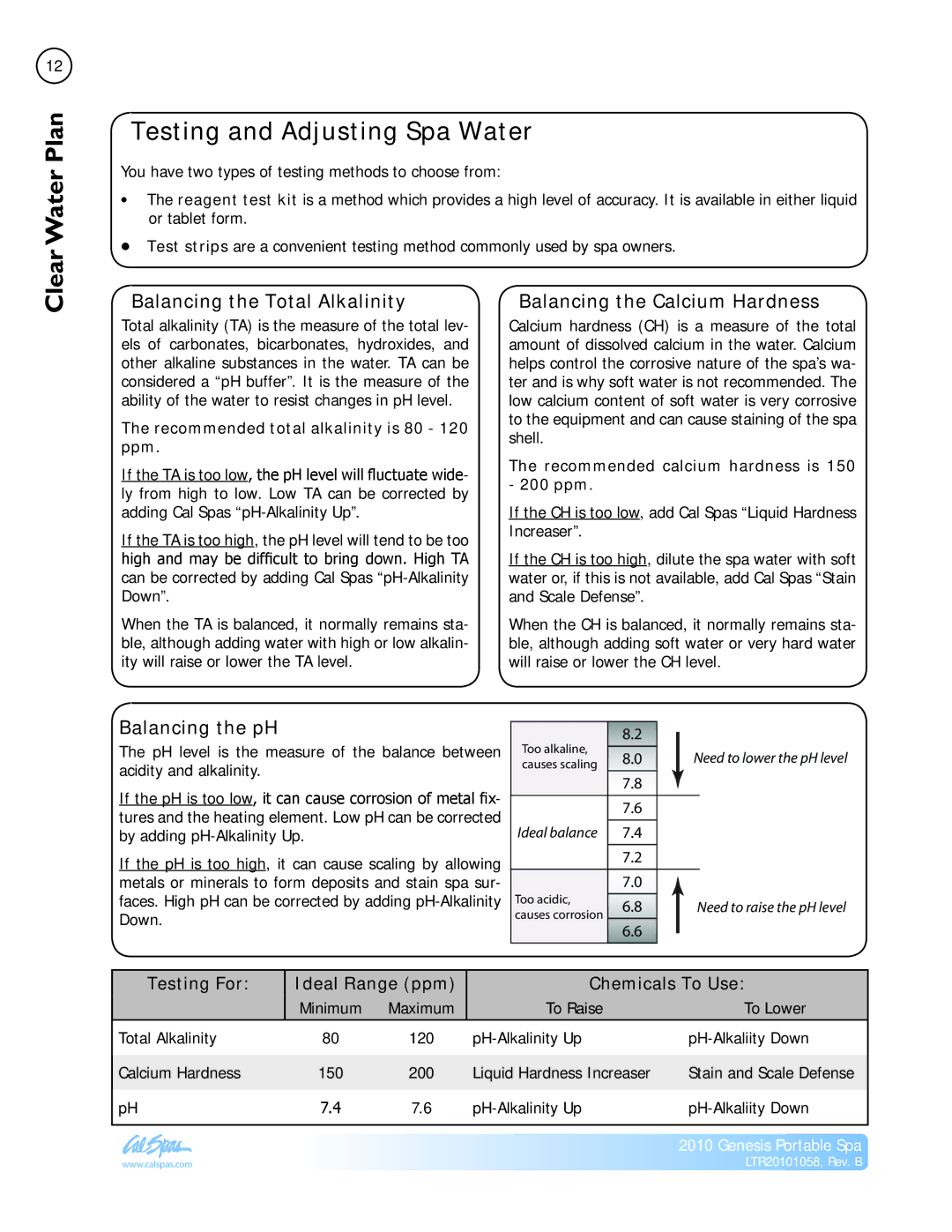
12
Clear PlanWater
Testing and Adjusting Spa Water
You have two types of testing methods to choose from:
•The reagent test kit is a method which provides a high level of accuracy. It is available in either liquid or tablet form.
•Test strips are a convenient testing method commonly used by spa owners.
Balancing the Total Alkalinity | Balancing the Calcium Hardness |
Total alkalinity (TA) is the measure of the total lev- els of carbonates, bicarbonates, hydroxides, and other alkaline substances in the water. TA can be considered a “pH buffer”. It is the measure of the ability of the water to resist changes in pH level.
The recommended total alkalinity is 80 - 120 ppm..
If the TA is too low, the pH level will fluctuate wide- ly from high to low. Low TA can be corrected by adding Cal Spas
If the TA is too high, the pH level will tend to be too high and may be difficult to bring down. High TA can be corrected by adding Cal Spas
When the TA is balanced, it normally remains sta- ble, although adding water with high or low alkalin- ity will raise or lower the TA level.
Calcium hardness (CH) is a measure of the total amount of dissolved calcium in the water. Calcium helps control the corrosive nature of the spa’s wa- ter and is why soft water is not recommended. The low calcium content of soft water is very corrosive to the equipment and can cause staining of the spa shell.
The recommended calcium hardness is 150 - 200 ppm..
If the CH is too low, add Cal Spas “Liquid Hardness Increaser”.
If the CH is too high, dilute the spa water with soft water or, if this is not available, add Cal Spas “Stain and Scale Defense”.
When the CH is balanced, it normally remains sta- ble, although adding soft water or very hard water will raise or lower the CH level.
Balancing the pH
The pH level is the measure of the balance between acidity and alkalinity.
If the pH is too low, it can cause corrosion of metal fix- tures and the heating element. Low pH can be corrected by adding
If the pH is too high, it can cause scaling by allowing metals or minerals to form deposits and stain spa sur- faces. High pH can be corrected by adding
Too alkaline, | 8.2 |
| |
8.0 | Need to lower the pH level | ||
causes scaling | |||
| 7.8 |
| |
| 7.6 |
| |
Ideal balance | 7.4 |
| |
| 7.2 |
| |
| 7.0 |
| |
Too acidic, | 6.8 | Need to raise the pH level | |
causes corrosion | |||
6.6 |
| ||
|
|
Testing For: | Ideal Range (ppm) | Chemicals To Use: | ||
| Minimum | Maximum | To Raise | To Lower |
Total Alkalinity | 80 | 120 | ||
Calcium Hardness | 150 | 200 | Liquid Hardness Increaser | Stain and Scale Defense |
pH | 7.4 | 7.6 | ||
|
|
|
|
|
|
|
|
| 2010 Genesis Portable Spa |
www.calspas.com | LTR20101058, Rev. B |
